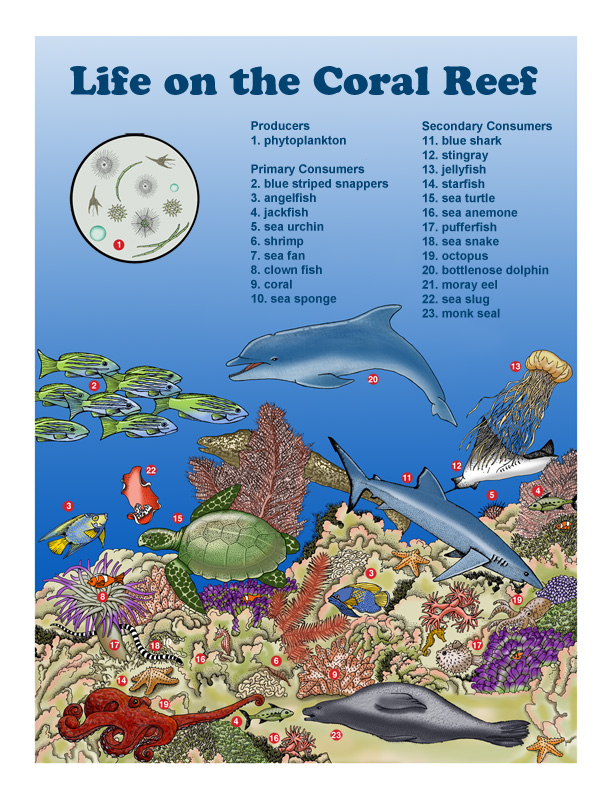

Coral reefs are one of Earth’s most diverse habitats. There are many different kinds of animals and plants making their living on a coral reef. Reefs lie along coasts of many tropical locations. They need certain environmental factors to survive, which warm coastlines can provide. They need a salty, warm environment (between 68° and 82° F). This keeps the reefs healthy and thriving. They need areas that are constantly churned by the waves to shower them with bits of food over and over. The waves also stir up oxygen over the reefs that the animals there need. The waves keep sand from building up on the coral anchored there. Coral are animals and cannot survive if they are buried in sand.
Coral reefs have a partnership with an alga called zooxanthellae that lives in the coral tissue itself. Zooxanthellae alga provides food and oxygen to the coral while taking up the carbon dioxide that the coral releases. The coral provides the algae with a safe place to live and grow. Zooxanthellae alga gives coral its many pretty colors. Zooxanthellae alga is very sensitive to pollution or the water temperature changes. It will die and the coral loses its pretty colors. This is called coral bleaching. It is a sign of an unhealthy coral reef.
Coral is also killed by collectors. They harvest colorful corals and fish to sell to aquariums and shell trade markets. Visiting tourists, who go snorkeling on the reefs, walk on the fragile plants and animals. Boaters pollute the delicately balanced habitat.
Coral reefs are a beautiful and diverse habitat. They provide a home for many of our favorite exotic fish and animals. They are wondrous place to explore. They also are sensitive and are the first ecosystem along our tropical coastlines to show the effects of abuse and pollution. They are a good early warning system that we need to pay attention to our oceans! If their destruction continues, we will lose these amazing habitats.
Coral reefs are one of our most biologically diverse habitats, but they are also very delicate and are in serious danger. In 1998 President Clinton helped establish the U.S. Coral Reef Task Force to better preserve and protect coral reef ecosystems.
There are many ways people can protect coral reefs. Never run your boat into coral. Watch for the brown color of shallow water. Dont ever anchor a boat on coral. Use a coral reef buoy, if there is one, or anchor in the sand nearby. Never dump trash or dirty water (bilge) near a coral reef. They are very sensitive. You can snorkel over a reef, but never step on coral. It is a living animal. Dont troll (drag a hook) near a coral reef. Hooks can injure coral.
Don’t support coral reef harvesters. Never buy coral for your fish tank unless it is been stamped with Marine Aquarium Council (MAC) stamp. This makes sure the coral was raised for aquariums and not from a wild reef.
(This is included in the PDF)
Coral Reef Read and React Quiz
Their Importance and Protection
1) Which tropical coast traits are best for coral reefs?
a) warm, freshwater
b) warm, salt water
c) cold, freshwater
d) cold, salt water
2) Name three reasons why wave action is important to coral reefs?
3) Which statement is true about coral reefs and zooxanthellae?
a) Zooxanthellae provides food and oxygen to the coral.
b) Zooxanthellae takes up the carbon dioxide that the coral releases.
c) Zooxanthellae alga is very sensitive to pollution.
d) It the Zooxanthellae dies, the coral loses its pretty colors – this is called coral bleaching.
e) All of the above.
4) Name three other ways coral reefs are damages by people?
5) Which of the following statements about coral reefs is FALSE.
a) Coral reefs are a beautiful and diverse habitats.
b) Coral reefs are a good early warning system that we need to pay attention to our oceans.
c) Coral reefs are too full of poisonous animals to be safe for humans to snorkel over.
d) Coral reefs provide a home for many of our favorite exotic fish and animals.
When you research information you must cite the reference. Citing for websites is different from citing from books, magazines and periodicals. The style of citing shown here is from the MLA Style Citations (Modern Language Association).
When citing a WEBSITE the general format is as follows.
Author Last Name, First Name(s). "Title: Subtitle of Part of Web Page, if appropriate." Title: Subtitle: Section of Page if appropriate. Sponsoring/Publishing Agency, If Given. Additional significant descriptive information. Date of Electronic Publication or other Date, such as Last Updated. Day Month Year of access < URL >.
Amsel, Sheri. "Coral Reefs in Peril" Exploring Nature Educational Resource ©2005-2024. December 13, 2024
< http://mail.exploringnature.org/db/view/1802 >

